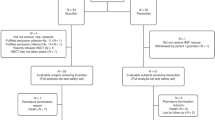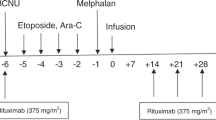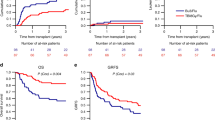Abstract
The purpose of this study was to evaluate the toxicity and efficacy of high-dose busulfan, melphalan and thiotepa (Bu/Mel/TT) in patients with high-risk non-inflammatory breast cancer defined as stage II disease ⩾10 lymph nodes (n = 52) or stage III (n = 69), and prognostic factors for treatment outcome. One hundred and twenty-one patients (median age, 46 years) were treated with high-dose Bu (12 mg/kg), Mel (100 mg/m2) and TT (500 mg/m2) (HDC) followed by autologous stem cell infusion (ASCI). One hundred patients were initially treated with surgery followed by standard adjuvant chemotherapy prior to HDC/ASCI. Twenty-one patients with stage III disease had inoperable tumors at diagnosis and were treated with neoadjuvant chemotherapy and surgery before HDC/ASCI. Transplant-related mortality was 6%. The probabilities of event-free survival (EFS) at 3 and 5 years (median follow-up of 36 months) from transplant were, for all patients: 0.62–0.60; stage II: 0.71–0.67: stage III: 0.55–0.55 (for stage III adjuvant and neoadjuvant groups: 0.60–0.60 and 0.42–0.42, respectively). Multivariate analysis did not identify variables associated with poor outcome. The efficacy of Bu/Mel/TT is similar to other HDC regimens reported for patients with high-risk non-inflammatory breast cancer. Bu/Mel/TT has high activity in stage II disease and a moderate benefit in stage III operable tumors. Bone Marrow Transplantation (2000) 26, 51–59.
This is a preview of subscription content, access via your institution
Access options
Subscribe to this journal
Receive 12 print issues and online access
$259.00 per year
only $21.58 per issue
Buy this article
- Purchase on Springer Link
- Instant access to full article PDF
Prices may be subject to local taxes which are calculated during checkout


Similar content being viewed by others
References
Buzzoni R, Bonadonna G, Valagussa P, Zambetti M . Adjuvant chemotherapy with doxorubicin plus cyclophosphamide, methotrexate, and fluorouracil in the treatment of resectable breast cancer with more than three positive axillary nodes J Clin Oncol 1991 9: 2134–2140
Bonadonna G, Zambetti M, Valagussa P . Sequential or alternating doxorubicin and CMF regimens in breast cancer with more than three positive nodes. Ten-year results JAMA 1995 273: 542–547
Jones SE, Moon TE, Bonadonna G et al. Comparison of different trials of adjuvant chemotherapy in stage II breast cancer using a natural history data base Am J Clin Oncol 1987 10: 387–395
Carter CL, Allen C, Henson DE . Relation of tumor size, lymph node status, and survival in 24740 breast cancer cases Cancer 1989 63: 181–187
Davidson NE, Abeloff MD . Adjuvant systemic therapy in women with early-stage breast cancer at high risk for relapse J Natl Cancer Inst 1992 84: 301–305
Buzdar AU, Kau SW, Hortobagyi GN et al. Clinical course of patients with breast cancer with ten or more positive nodes who were treated with doxorubicin-containing adjuvanttherapy Cancer 1992 69: 448–452
Bonadonna G, Valagussa P, Moliterni A et al. Adjuvant cyclophosphamide, methotrexate, and fluorouracil in node-positive breast cancer: the results of 20 years of follow-up New Engl J Med 1995 332: 901–906
Piccart MJ, de Valeriola D, Paridaens R et al. Six-year results of a multimodality treatment strategy for locally advancedbreast cancer Cancer 1988 62: 2501–2506
Hortobagyi GN, Singletary SE, McNeese HD . Treatment of locally advanced and inflamamtory breast cancer. In: Harris JR, Lippman ME, Morrow M, Hellman S (eds) Diseases of the Breast Lippincot-Raven: Philadelphia 1996 pp585–599
Hryniuk W, Bush H . The importance of dose-intensity in chemotherapy of metastatic breast cancer J Clin Oncol 1984 2: 1281–1288
Tannock IF, Boyd NF, De Boer G et al. A randomized trial of two dose levels of cyclophosphamide, methotrexate, and fluorouracil chemotherapy for patients with metastatic breast cancer J Clin Oncol 1988 6: 1377–1387
Bonnadona G, Valagussa P . Dose-intense adjuvant treatment of high-risk breast cancer J Natl Cancer Inst 1990 82: 53–54
Abeloff MD, Beveridge RA, Donehower RC et al. Sixteen-week dose-intense chemotherapy in the adjuvant treatment of breast cancer J Natl Cancer Inst 1990 82: 570–574
Wood CW, Budman DR, Korzum AH et al. Dose and dose intensity of adjuvant chemotherapy for stage II, node-positive breast carcinoma New Engl J Med 1994 330: 1253–1259
Peters WP, Ross M, Vredenburgh JJ et al. High-dose chemotherapy and autologous bone marrow support as consolidation after standard-dose adjuvant therapy for high-risk primarybreast cancer J Clin Oncol 1993 11: 1132–1143
Somlo G, Doroshow J, Forman S et al. High-dose chemotherapy and stem cell rescue in the treatment of high-riskbreast cancer: prognostic indicators of progression-free and overall survival J Clin Oncol 1997 15: 2882–2893
Gianni A, Siena S, Bregni M et al. Efficacy, toxicity and applicability of high-dose sequential chemotherapy as adjuvant treatment in operable breast cancer with 10 or more involved axillary nodes; five-year results J Clin Oncol 1997 15: 2312–2321
Tomas JF, Perez-Carrion R, Escudero A et al. Results of a pilot study of 40 patients using high-dose therapy with hematopoietic rescue after standard-dose adjuvant therapy for high-risk breast cancer Bone Marrow Transplant 1997 19: 661–670
Garcia-Carbonero R, Hidalgo M, Paz-Ares L et al. Patient selection in high-dose chemotherapy trials: relevance in high-risk breast cancer J Clin Oncol 1997 15: 3178–3184
Rhodenhuis S, Richel D, van der Wall E et al. Randomised trial of high-dose chemotherapy and haemopoietic progenitor-cell support in operable breast cancer with extensive axillary lymph-node involvement Lancet 1998 352: 515–521
Schwartzberg L, Birch R, West W et al. Sequential treatment including high-dose chemotherapy with peripheral blood stem cell support in patients with high-risk stage II–III breast cancer Am J Clin Oncol 1998 21: 523–531
Hortobagyi GN, Buzdar AU, Theriault RL et al. Randomized trial of high-dose chemotherapy and blood cell autografts for high-risk primary breast carcinoma J Natl Cancer Inst 2000 92: 225–233
Weaver C, Bensinger W, Appelbaum F et al. Phase I study of high-dose busulfan, melphalan and thiotepa with autologous stem cell support in patients with refractory malignancies Bone Marrow Transplant 1994 14: 813–819
Schiffman K, Bensinger W, Appelbaum F et al. Phase II of high-dose busulfan, melphalan and thiotepa with autologous peripheral blood stem cell support in patients with malignant disease Bone Marrow Transplant 1996 17: 943–950
Bensinger W, Schiffman, Holmberg L et al. High-dose busulfan, melphalan, thiotepa and peripheral blood stem cell infusion for the treatment of metastatic breast cancer Bone Marrow Transplant 1997 19: 1183–1189
American Joint Committee on Cancer. Breast. In: Fleming I, Cooper J, Henson D et al (eds) AJCC Cancer Staging Manual, 5th edn Lippincot-Raven: Philadelphia 1997 pp171–180
Haagensen C . Clinical classification of the stage of advancement of breast carcinoma. In: Diseases of the Breast, 3rd edn WB Saunders: Philadelphia 1986 pp851–863
Bensinger W, Singer J, Appelbaum F et al. Autologous transplantation with peripheral blood mononuclear cells collected after administration of recombinant granulocyte stimulating factor Blood 1993 81: 3158–3163
Rowley SD, Bensinger W, Gooley T et al. The effect of cell concentration on bone marrow and peripheral blood stem cell cryopreservation Blood 1994 83: 2731–2736
Bearman S, Appelbaum F, Buckner C et al. Regimen-related toxicity in patients undergoing bone marrow transplantation J Clin Oncol 1988 6: 1562–1568
Cox DR . Regression models and life tables JR Stat Soc B 1972 34: 187–202
SAS Institute Inc. Technical report P-217, SAS/STAT Software; the PHREG Procedure Version 6. SAS Institute Inc: Cary, NC 1991 p63
Kaplan EL, Meier P . Nonparametric estimation from incomplete observations J Am Stat Assoc 1958 53: 457–481
Peters WP, Rosner G, Vredenburgh JJ et al. A prospective, randomized comparison of two doses of combination alkylating agents as consolidation after CAF in high-risk primary breast cancer involving ten or more axillary lymph nodes: preliminary results of CALGB 9082/SWOG 9114/NCIC MA-13 Proc Am Soc Clin Oncol 1999 18: (Abstr.2)
The Scandinavian Breast Cancer Study Group . Results from a randomized adjuvant breast cancer study with high dose chemotherapy with CTCb supported by autologous bone marrow stem cells vs dose escalated and tailored FEC therapy Proc Am Soc Clin Oncol 1999 18: (Abstr.3)
Bezwoda WR . Randomised, controlled trial of high dose chemotherapy (HD-CNVp) vs standard dose (CAF) chemotherapy for high risk, surgically treated, primary breast cancer Proc Am Soc Clin Oncol 1999 18: (Abstr.4)
Weiss RB, Rifkin RM, Stewart FM et al. High-dose chemotherapy for high-risk primary breast cancer: an on-site review of the Bezwoda study Lancet 2000 355: 999–1003
Antman K, Rowlings P, Vaughan W et al. High-dose chemotherapy with autologous hematopoeitic stem-cell support for breast cancer in North America J Clin Oncol 1997 15: 1870–1879
Anderson JR, Cain KC, Gelber RD, Gelman RS . Analysis and interpretation of the comparison of survival by treatment outcome variables in cancer clinical trials Cancer Treat Rep 1985 69: 1139–1144
Antman K, Ayash L, Elis A et al. A phase II study of high-dose cyclophosphamide, thiotepa, and carboplatin with autologous marrow support in women with measurable advanced breast cancer responding to standard-dose therapy J Clin Oncol 1992 10: 102–110
Schiffman K, Buckner C, Maziarz R et al. High-dose busulfan, melphalan, and thiotepa followed by autologous peripheral blood stem cell transplantation in patients with aggressive lymphoma or relapsed Hodgkin's disease Biol Blood Marrow Transplant 1997 3: 261–266
Holmberg L, Demirer T, Rowley S et al. High-dose busulfan, melphalan and thiotepa followed by autologous peripheral blood stem cell (PBSC) rescue in patients with advanced stage III/IV ovarian cancer Bone Marrow Transplant 1998 22: 651–659
Grochow LB . Busulfan disposition: the role of therapeutic monitoring in bone marrow transplantation Semin Oncol 1993 20: (Suppl.4) 18–25
Kuerer HM, Newman LA, Smith TL et al. Clinical course of breast cancer patients with complete pathologic primary tumor and axillary lymph node response to doxorubicin-based neoadjuvant chemotherapy J Clin Oncol 1999 17: 460–469
Acknowledgements
This study was supported by grants from the National Institutes of Health CA 47748, CA 18221, CA 15704, CA 09515 and the Jose Carreras International Leukemia Foundation. FG-D is supported by a grant from Instituto Mexicano del Seguro Social (IMSS), Mexico City, Mexico.
Author information
Authors and Affiliations
Rights and permissions
About this article
Cite this article
Gutierrez-Delgado, F., Holmberg, L., Hooper, H. et al. High-dose busulfan, melphalan and thiotepa as consolidation for non-inflammatory high-risk breast cancer. Bone Marrow Transplant 26, 51–59 (2000). https://doi.org/10.1038/sj.bmt.1702461
Received:
Accepted:
Published:
Issue Date:
DOI: https://doi.org/10.1038/sj.bmt.1702461
Keywords
This article is cited by
-
High-dose thiotepa, melphalan and carboplatin (TMCb) followed by autologous stem cell transplantation in patients with advanced breast cancer: a retrospective evaluation
Bone Marrow Transplantation (2003)
-
Autologous stem cell transplantation for non-Hodgkin's lymphoma: comparison of radiation-based and chemotherapy-only preparative regimens
Bone Marrow Transplantation (2001)



